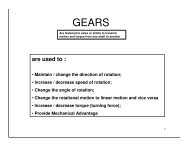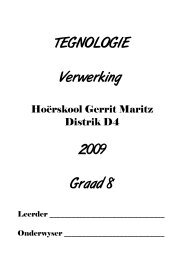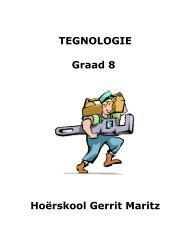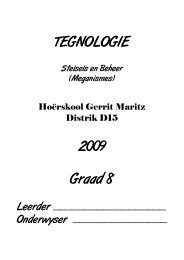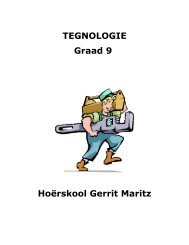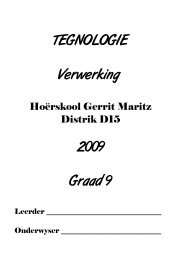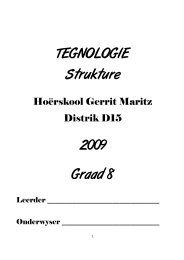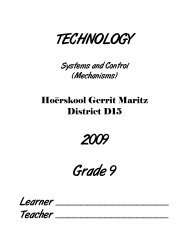TECHNOLOGY Processing 2009 Grade 8 - Tegnologie
TECHNOLOGY Processing 2009 Grade 8 - Tegnologie
TECHNOLOGY Processing 2009 Grade 8 - Tegnologie
Create successful ePaper yourself
Turn your PDF publications into a flip-book with our unique Google optimized e-Paper software.
Textiles<br />
Textiles have been used for clothes and shelters for hundreds of years. Much earlier animal<br />
skins and natural textiles like wool, cotton and silk were used. The development of technology<br />
has provided a great variety of manmade textiles for the modern day technologist. Examples<br />
are nylon, polyester, and acrylics.<br />
Textiles are made by weaving or knitting fibres together, sometimes it is only squashed<br />
together and is kept together by the friction between the fibres. Some fabrics consist of layers<br />
which are bonded together and covered with plastic layer to make it water resistant. Strength<br />
of fabrics depends on the weaving methods and the type of fibre used.<br />
Other properties which are of importance are flexibility, water resistance, ventilation, isolation<br />
against heat and cold, wind resistance, shrinking and stain resistance. The properties of<br />
fabrics especially the strength, stiffness and tear resistance depends on the direction in which<br />
the force is applied.<br />
Compare properties of natural and manmade textiles:<br />
Fabric Absorbtion<br />
Quick<br />
drying<br />
Warm/<br />
cool<br />
Burns<br />
easily<br />
Elastic<br />
Wrinkle<br />
s easily<br />
Strong<br />
when<br />
wet<br />
wool high no warm no no no no high<br />
cotton high no cool yes no yes yes average<br />
silk high yes warm yes no yes no high<br />
linen high yes cool yes no yes yes high<br />
Rayon<br />
viscose<br />
Nylon &<br />
polyester<br />
high yes cool<br />
Burns<br />
and<br />
melts<br />
Cost<br />
no no yes low<br />
low yes warm melts yes no yes low<br />
acrylics low yes warm<br />
Burn<br />
and<br />
melts<br />
yes no yes low<br />
Case Study 1: Date_______________________<br />
Textiles are often mixed which means that there can be natural as well as sinthetic fibres in<br />
clothes, carpets, curtains or upholstery.<br />
Look at the properties of the different textiles mentioned above and then discuss the reasons<br />
for the following combinations:<br />
Stretch denim: 98% cotton, 2% acrylics<br />
__________________________________________________________________________<br />
__________________________________________________________________________<br />
Tracksuit: 69% cotton, 31% acrylics<br />
__________________________________________________________________________<br />
__________________________________________________________________________





